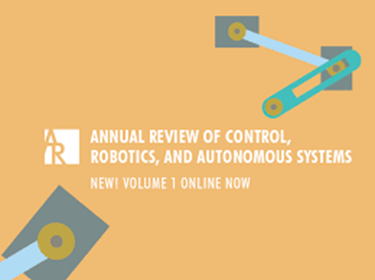Embodied Communication: How Robots and People Communicate Through Physical Interaction
IF 14
1区 计算机科学
Q1 AUTOMATION & CONTROL SYSTEMS
Annual Review of Control Robotics and Autonomous Systems
Pub Date : 2023-01-09
DOI:10.1146/annurev-control-070122-102501
引用次数: 5
Abstract
Early research on physical human–robot interaction (pHRI) has necessarily focused on device design—the creation of compliant and sensorized hardware, such as exoskeletons, prostheses, and robot arms, that enables people to safely come in contact with robotic systems and to communicate about their collaborative intent. As hardware capabilities have become sufficient for many applications, and as computing has become more powerful, algorithms that support fluent and expressive use of pHRI systems have begun to play a prominent role in determining the systems’ usefulness. In this review, we describe a selection of representative algorithmic approaches that regulate and interpret pHRI, describing the progression from algorithms based on physical analogies, such as admittance control, to computational methods based on higher-level reasoning, which take advantage of multimodal communication channels. Existing algorithmic approaches largely enable task-specific pHRI, but they do not generalize to versatile human–robot collaboration. Throughout the review and in our discussion of next steps, we therefore argue that emergent embodied dialogue—bidirectional, multimodal communication that can be learned through continuous interaction—is one of the next frontiers of pHRI. Expected final online publication date for the Annual Review of Control, Robotics, and Autonomous Systems, Volume 14 is May 2023. Please see http://www.annualreviews.org/page/journal/pubdates for revised estimates.体现交流:机器人和人如何通过物理互动进行交流
早期对物理人机交互(pHRI)的研究必然集中在设备设计上——创建兼容和传感器硬件,如外骨骼、假体和机器人手臂,使人们能够安全地与机器人系统接触,并就他们的协作意图进行交流。随着硬件能力对许多应用程序来说已经足够,并且随着计算变得更加强大,支持pHRI系统流畅和表达性使用的算法已经开始在确定系统的有用性方面发挥突出作用。在这篇综述中,我们描述了调节和解释pHRI的代表性算法方法的选择,描述了从基于物理类比的算法(如导纳控制)到基于高级推理的计算方法(利用多模态通信通道)的进展。现有的算法方法在很大程度上支持特定于任务的pHRI,但它们不能推广到通用的人机协作。在整个回顾和我们下一步的讨论中,我们因此认为,紧急体现对话——双向、多模式的交流,可以通过持续的互动来学习——是pHRI的下一个前沿领域之一。预计《控制、机器人和自主系统年度评论》第14卷的最终在线出版日期是2023年5月。修订后的估计数请参阅http://www.annualreviews.org/page/journal/pubdates。
本文章由计算机程序翻译,如有差异,请以英文原文为准。
求助全文
约1分钟内获得全文
求助全文
来源期刊
CiteScore
28.30
自引率
2.20%
发文量
25
期刊介绍:
The Annual Review of Control, Robotics, and Autonomous Systems offers comprehensive reviews on theoretical and applied developments influencing autonomous and semiautonomous systems engineering. Major areas covered include control, robotics, mechanics, optimization, communication, information theory, machine learning, computing, and signal processing. The journal extends its reach beyond engineering to intersect with fields like biology, neuroscience, and human behavioral sciences. The current volume has transitioned to open access through the Subscribe to Open program, with all articles published under a CC BY license.

 求助内容:
求助内容: 应助结果提醒方式:
应助结果提醒方式:


